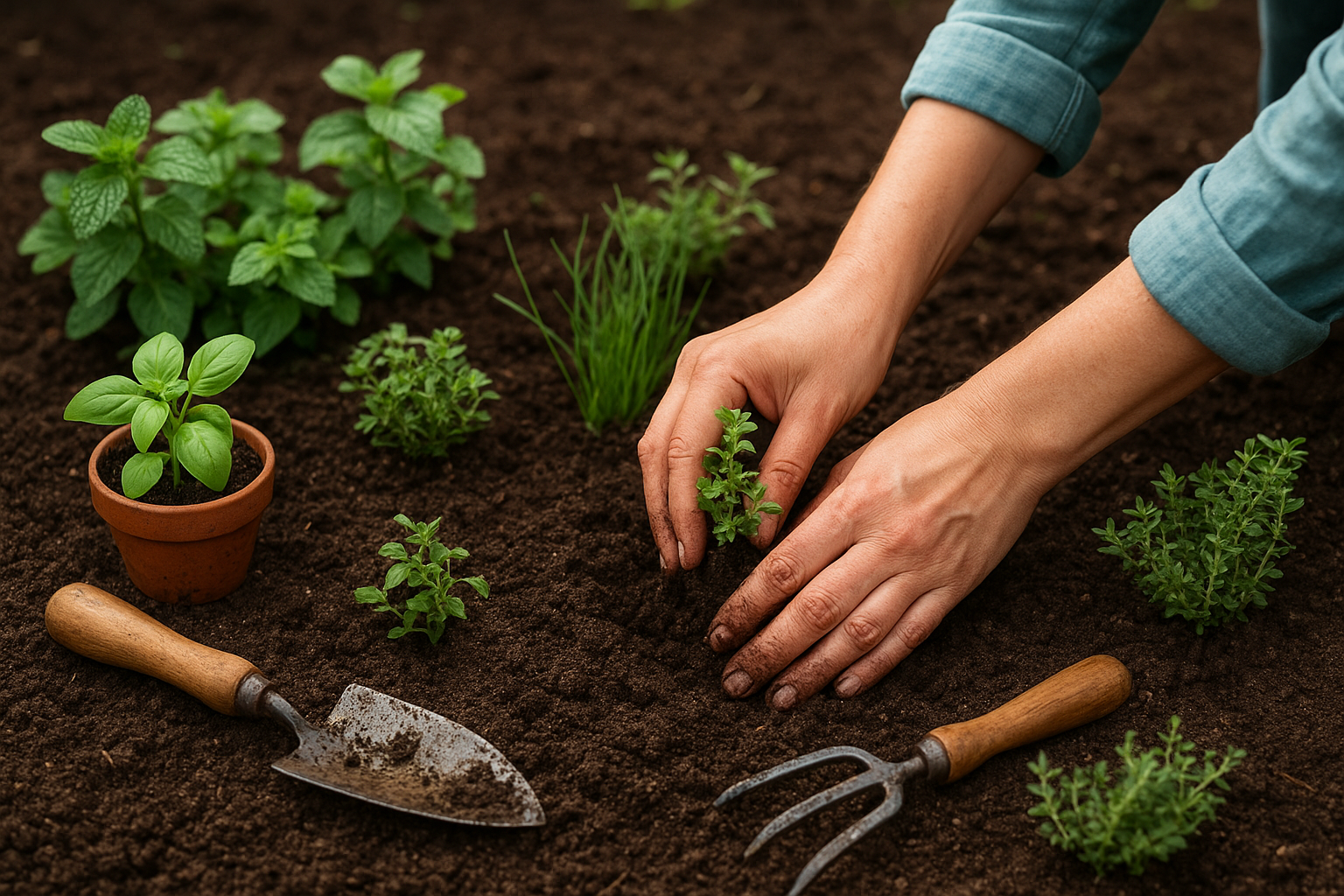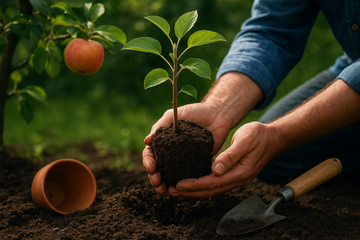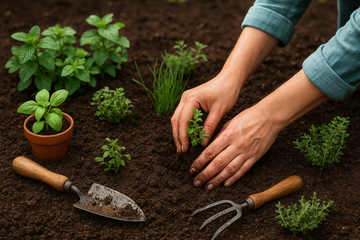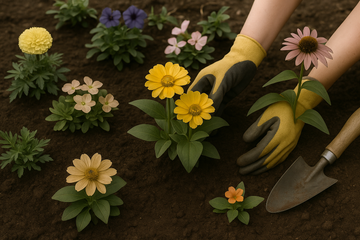Herb Gardening Made Easy: How to Plant Herbs Successfully
Herbs are among the easiest, most rewarding plants to grow. Whether you have a spacious backyard or a sunny windowsill, planting herbs gives you fresh flavors, aromatic joy, and a continual supply of kitchen greens. In this blog, we’ll walk you through the steps— from seed to harvest— and show you how to choose, sow, care for, and enjoy your own herb garden. We’ll even link you to SeedsChoice’s herb offerings so it’s simple to get started.
Why Grow Herbs from Seed?
Growing herbs from seed has several advantages:
-
Greater variety choices (you’re not limited to what nurseries stock)
-
More economical for many plants
-
Starting from seed gives control over organic or high-quality stock
-
You get the satisfaction of nurturing plants from the very start
How to Plant Herbs: Step-by-Step Guide
Here’s a typical workflow you can follow. Use this as a template and adjust for your climate, container size, or herb types.
1. Choose the Right Herbs
Start with easy, reliable herbs. Some beginner-friendly options:
-
Basil – fast germinator, excellent in containers
-
Chives – hardy and forgiving
-
Parsley – takes a little longer, but very useful
-
Thyme, Oregano, Rosemary – good for Mediterranean flavor and often drought tolerant
2. Gather Your Supplies
You’ll need:
-
Seed trays, small pots, or cells
-
Quality seed-starting mix (light and well-draining)
-
Clean water spray or fine watering can
-
Labels or markers
-
Grow light or a bright, warm window (if indoors)
-
Containers or garden beds for eventual transplanting
3. Sowing the Seeds
-
Moisten the seed mix before packing it into trays or pots
-
Place seeds on the surface (some herbs require light to germinate)
-
Lightly press them into the soil or sprinkle a thin dusting of fine mix on top
-
Mist or water gently
-
Cover with a clear lid or plastic wrap to maintain humidity (optional)
-
Keep in a warm spot (around 20–24 °C / 68–75 °F)
4. Germination & Early Care
-
Check daily for moisture; don’t let the soil dry out
-
Remove cover once seedlings emerge
-
Provide good light (12–16 hours of bright light or under grow lights)
-
Thin weaker seedlings so strong ones have space
-
Use gentle ventilation or air movement to strengthen stems
5. Transplanting / Potting Up
Once seedlings have their second set of true leaves:
-
Harden them off (if going outdoors) by gradually exposing them to wind and sun
-
Transplant into individual pots or garden beds
-
Use a well-draining potting mix (e.g. a blend of compost, perlite, and potting soil)
-
Water in gently
6. Ongoing Care & Maintenance
-
Watering: Keep soil evenly moist, but don’t overwater. Many herbs dislike soggy roots.
-
Fertilizing: Use a light, balanced fertilizer once a month (or compost tea)
-
Pruning / Harvesting: Regular harvesting encourages branching and more growth
-
Sunlight: Most herbs prefer 6+ hours of sun; some tolerate partial shade
-
Pot care: In containers, make sure drainage is good and repot or refresh soil every year
Growing Herbs in Containers vs Garden Beds
| Feature | Containers / Pots | Garden Beds / In-Ground |
|---|---|---|
| Control of soil | You control mix and drainage | Depends on your garden soil |
| Mobility | Easy to move (indoors/outdoors) | Fixed |
| Root space | Limited; choose smaller herbs or pot generously | More room for deeper-rooted herbs |
| Maintenance | More frequent watering | Less frequent (if soil holds moisture) |
| Risk of pests / diseases | Sometimes less, easier control | Higher exposure |
Many gardeners combine both: keep delicate herbs (like basil or mint) in containers and plant perennials (rosemary, thyme) in the ground.
Sample Herb Seeds to Try (and link to SeedsChoice alternatives)
Below are some example herbs (from other sellers) to illustrate what to look for. On your SeedsChoice store, you’d link to their equivalent herb seed products.
- Basil seeds – great for kitchen windowsills
- Lepidium sativum – fast-growing cress for microgreens
- Kitchen herb seeds (Bingenheimer) – assorted culinary herbs
- Lemon basil seeds – basil with a citrus twist
- Levisticum officinale (lovage) – a classic soup herb
- Perennial marjoram seeds – long-lasting marjoram variety
Tips to Maximize Your Herb Garden Success
-
Start with fast-growing herbs like basil, cilantro, and chives. These provide quick wins and confidence.
-
Use a light, airy seed-starting mix rather than garden soil.
-
Maintain consistent temperature & moisture during germination.
-
Provide bright light early — insufficient light leads to leggy, weak seedlings.
-
Label your trays — many herb seeds look similar when just sprouted.
-
Rotate pots if indoors to balance light exposure.
-
Use mulch or topdressing to conserve soil moisture in hot weather.
-
Companion planting: Some herbs grow well with vegetables (e.g. basil near tomatoes), and some help repel pests.
Common Mistakes & How to Avoid Them
-
Overwatering – leads to damping-off or root rot
-
Insufficient light – causes elongated, pale seedlings
-
Crowding seedlings – leads to weak competition; thin early
-
Ignoring hardening off – sudden exposure can shock seedlings
-
Not refreshing soil in pots – nutrients deplete over time
FAQ Section (Herb Planting)
Q: When is the best time to plant herb seeds?
A: In most temperate climates, late winter to early spring is ideal for indoor sowing. Once frost risk passes, you can transplant outdoors. Herbs such as basil and cilantro prefer warm soil (~20 °C).
Q: Do all herbs need full sun?
A: Many do (6+ hours), but some herbs like mint, parsley, or chervil can tolerate partial shade. Choose your herb list to match your light conditions.
Q: Can I sow herbs directly outdoors (direct seeding)?
A: Yes, for hardy herbs like parsley, chives, coriander in mild climates. For more delicate ones (basil, thyme), starting indoors gives them a better start.
Q: How long until I can harvest herbs?
A: Depends on species. Fast herbs like basil or cress may be ready in 4–6 weeks. Perennials (thyme, oregano) can take a season to fully establish.
Q: Do herbs need fertilizer?
A: Light feeding is beneficial. Once a month with a balanced, dilute fertilizer or compost tea works well. Avoid overfeeding, as it can reduce flavor intensity.
Q: Can I grow herbs year-round indoors?
A: Absolutely—provided you supply enough light (natural or artificial) and manage temperature/humidity. Many urban gardeners maintain herbs like basil, mint, chives indoors all year.
Q: Why did my herb seed fail to germinate?
A: Common causes include old seeds, improper moisture (too dry or too wet), low temperature, or poor light. Always follow the seed packet’s instructions, and consider buying seed lots with good germination rates
Conclusion & Next Steps
Planting herbs from seed is a deeply rewarding endeavor — you gain flavor, aroma, and a deeper connection to your food. With a bit of care, the right supplies, and quality seeds, even a small balcony or window ledge can become a thriving herb garden.
Here’s a checklist to get you started:
-
Pick 3–5 easy herbs suited to your light/space
-
Order quality seed packets from SeedsChoice
-
Set up seed trays with moist, airy mix
-
Provide warm, bright, consistent conditions
-
Transplant when seedlings are strong
-
Maintain with regular watering, feeding, and pruning












